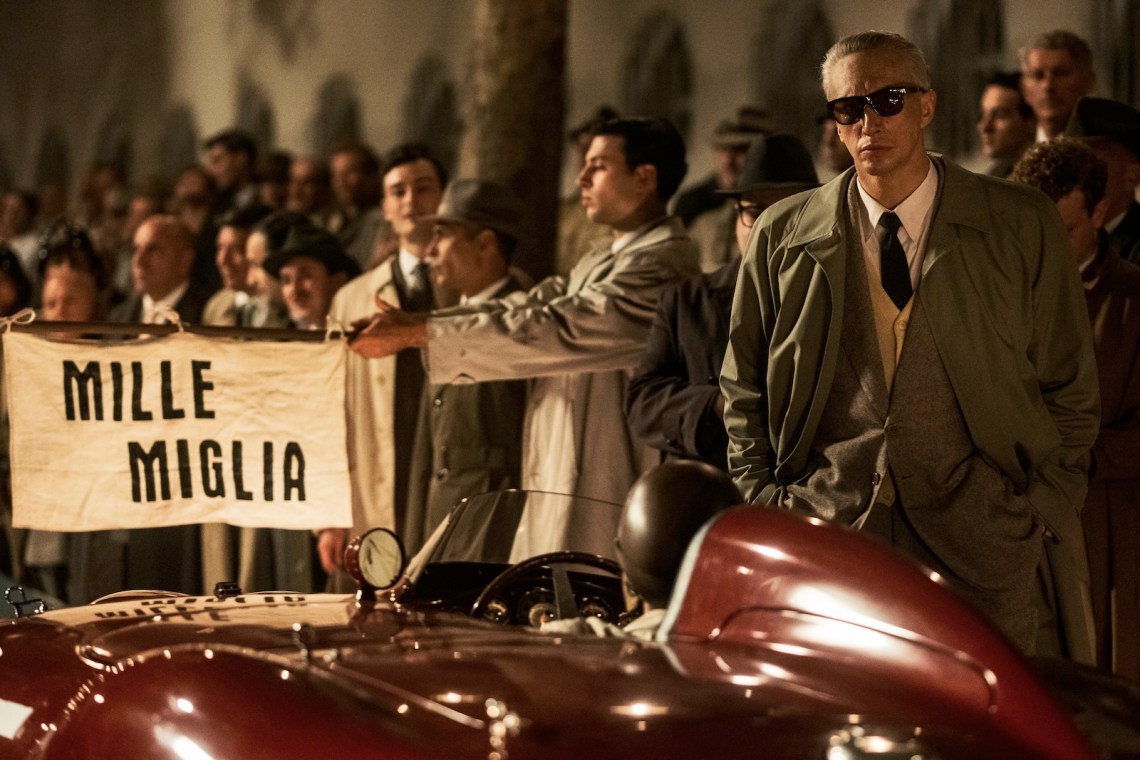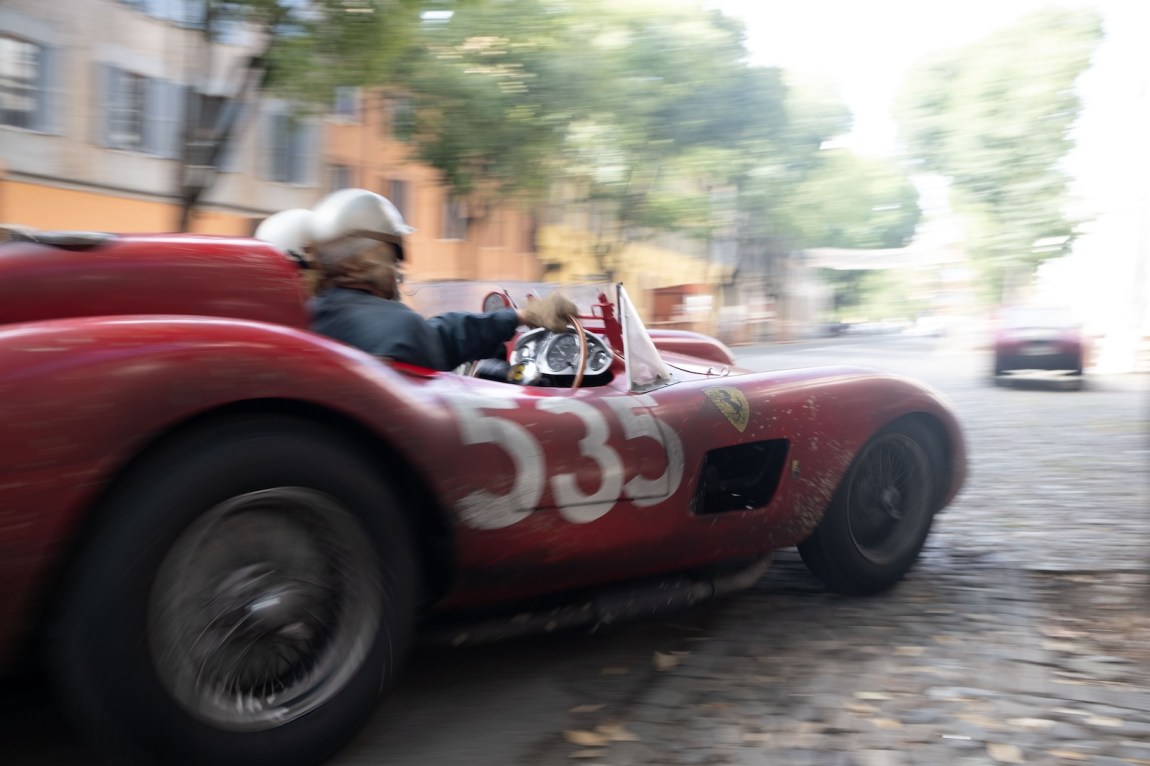Michael Mann’s attachment to Ferraris is well known. In his 1980s television series Miami Vice, Don Johnson played Sonny Crockett, an undercover narcotics agent who drove Ferraris that the Metro-Dade Police Department had seized from drug dealers. In Mann’s 2006 film version of the show, Crockett, now played by Colin Farrell, drove a dark gray Ferrari F430 Spider, a $175,000 convertible that goes from zero to sixty in under four seconds and at the time had a resale value of around $35,000, less if a cop had frigged it.
It’s ironic, then, that the quintessential American cop car, the lowly but powerful Ford Crown Victoria, had, until now, the most screen time in any of Mann’s films. In Collateral (2004), he deploys the Crown Vic not as a police cruiser but in its other standard role, as a yellow taxi. Jamie Foxx chauffeurs hitman Tom Cruise through the Los Angeles night as Cruise picks off witnesses in a drug case—a West Coast Miami Vice in reverse.
This taxicab aside, Ferraris will always define Mann in both the popular and the cinephile imagination. The association is solidified, almost carved in stone, in his latest film, a biopic starring Adam Driver as Enzo Ferrari, the former race car driver who founded Ferrari S.p.A in 1939. Vintage Ferraris, not the 1980s models, will ensure Mann’s legacy as a film director, the same way some men who get to a certain level of wealth start to fill their garages with them. The difference is that Mann has done it in art, not in life, putting Ferrari on the marquee above his oeuvre. Soon to turn eighty-one, Mann is as busy as ever. Last June he published the novel Heat 2, cowritten with Meg Gardiner, a sequel to his signature crime film. He also plans to bring it to the screen. But in Ferrari, Mann’s fixation on death, on the cemetery and the tomb, positions this melodrama as a consecration and summation of his life’s work.
*
Ferrari is death-haunted, even for a Mann film, even for a film set in Italy. Early in the film, before he visits a cemetery to pay a morning visit to his son Dino’s tomb, Enzo mentions a “perpetual twilight” in connection with his losing soccer team. This crepuscular sense of loss, present as he starts his day, hangs over the entire film. “We all know death is nearby,” an engineer tells Enzo much later in Ferrari, long after that has become clear to everyone in his life, to everyone in the Italy of 1957, and to everyone in the audience.
As played with great subtlety and control by Driver, Enzo Ferrari is a demonic but cool and collected presence. Driver’s icy nonchalance here contrasts greatly with his off-kilter performance in 2022’s White Noise—a tribute to Mann as a director of actors, not just automobiles. Whether playing Enzo in the guise of industrial designer (a craftsman of the old school), scuderia owner (a sportsman obsessed with winning but a gentleman all the same), husband (an adulterer), or grieving or loving father, the actor, like his director, is sly but guileless. He never quite allows us to understand Enzo’s true degree of self-knowledge, except when he’s scamming the Italian press.
Enzo thinks he’s in control because he does understand that at the bottom of his success is the inevitability of death. To live so close to it is not normal, but it is exciting, and lucrative. Yet fate, and his wife, Laura (Penélope Cruz), are always a step ahead. During the film’s first visit to the Ferrari test track, Enzo tells a young driver he doesn’t need another racer on his team. Then the film’s first crash happens, hurling a red Ferrari through the air, killing the driver. The eager replacement just happens to be standing right next to him. A typical morning for Enzo, who has already been shot at by Laura.
Cruz embodies the Mannian woman in a new way. She plays Laura as a smoldering life force and great business mind who, like her husband, plays things close to the vest. She is the first woman in Mann’s films whose husband listens to her and follows her advice. When Khalilah Ali (Nona Gaye) explained to her husband Muhammad (Will Smith) that he was being exploited in Mann’s other biopic, Ali (2001), he paid her no mind and left her. Here, Enzo understands that he isn’t and can’t be free. At his factory a pigeon is kept in a cage with an open door. The pigeon chooses not to leave. “Freedom for that pigeon is pigeon pie,” he explains.
Advertisement
*
Speed is religion in Ferrari, as shown in a scene set in church during morning Mass. The church is near Maserati’s test track, and the Ferrari executives and workers in the pews can hear the cars revving and shifting into high gear under the priest’s invocations. As a group, they bring out stopwatches to time the test runs of the new Maseratis they will be competing against in the upcoming 1957 Mille Miglia, a race described this way by the sportswriter Brock Yates, in his 1991 biography of Enzo Ferrari, The Man and the Machine, which is the basis of Mann’s film:
The notion of fast cars racing on real roads, around twisting mountain hairpins and through narrow city streets, was the embodiment of every man’s fantasy to charge down an open road flat out, unencumbered by laws or moral and social impediments of any kind. For all its insanity, the Mille Miglia…[encompassed] “an entire lifetime condensed into a few hours.”…To have [competed in it] meant that a man had faced down the specter of violent death for half a day over some of the most difficult and unforgiving roadways in the entire world.
It is this fatal mindset that Fellini mocked in the “Toby Dammit” section of Spirits of the Dead (1968), in which Terence Stamp races through the nighttime streets of Rome in a prize Ferrari until a wire stretched across the road decapitates him.
Ferrari’s journey to the screen was not so fast. The film’s screenwriter, Troy Kennedy Martin, died in 2009. Christian Bale was supposed to play Enzo; instead he ended up in a different Formula One movie, James Mangold’s Ford v. Ferrari (2019), playing the race car driver Ken Miles. Then it was supposed to be Hugh Jackman. Creating the illusion of speed can be a slow process. It took patience.
At times in Ferrari serenity takes over. A scene of Enzo showing his surviving son engine plans and explaining the utilitarian aspects of beauty to him becomes the film’s calm center. “When a thing works better usually it is more beautiful to the eye,” he says, underlining Mann’s approach in this burnished film of bright red and yellow cars set against green and pale blue landscapes and gray-brown factory interiors.
Racing movies have always had a special place in the cinema, going back at least to Howard Hawks’s The Crowd Roars in 1932. Hawks updated the genre for color (and product branding) in 1965 for Red Line 7000. In the late 1960s and early 1970s big-star auto racing vehicles followed, with James Garner, Paul Newman, Steve McQueen. Cars on a track replicate the motion of the cinema itself—reels going round like wheels, the film strip a ribbon of road, a circular motion that keeps going and indicates an infinite replaceability, an anonymity of actors hard to tell apart in helmets and goggles, just part of the machinery.
What interrupts this flow is the paradoxical reason for the existence of these movies: the car crash. Mann, in this regard, does not disappoint. The fatal accident at the test track early in Ferrari is a shocking moment, but brief, quickly integrated into the course of things, and all but forgotten by the time the infamous crash of the 1957 Mille Miglia has to—inevitably—be recreated. Mann does not balk. He presents the crash as a harrowing “holy shit!” moment involving a child. It is a new Odessa Steps sequence of deadly, wasteful capitalist excess, ending with nine spectators dead.
The driver, Alfonso de Portago (Gabriel Leone), lies on the road cut in two, his Ferrari a compacted John Chamberlain sculpture. The traveling shot in this scene becomes a grotesque response to Enzo’s lecture to his scuderia at a team luncheon earlier in the film, one that also underlined his status as a man with two families, one hidden—“Two objects cannot occupy the same point in space at the same moment in time.”
*
In 1909 the Italian protofascist poet Filippo Tommaso Marinetti published his Futurist Manifesto, a bizarre, hysterical, racist-sexist celebration of speed and machinery that welcomed the new twentieth century as an epoch of violence and rejected past notions of how to live. He demanded glorious deaths in car crashes, and lauded war and destruction. “Time and space died yesterday!” Marinetti screamed. “We declare that the splendor of the world has been enriched by a new beauty: the beauty of speed. A racing automobile with its bonnet adorned with great tubes like serpents with explosive breath…a roaring motor car which seems to run on machine-gun fire”—this was his example of the new beauty that would replace the natural world.
One of the many things Marinetti opposed was museums. He identified them with cemeteries. “Museums, cemeteries!” he shouted. “Truly identical in their sinister juxtaposition of bodies that do not know each other.” Seventy or so years later, after two world wars, Paul Virilio, the anti-speed cultural theorist, proposed a “Museum of Accidents” that could keep us from becoming habituated to the terror and violence created by new technologies. Virilio studied what he called speed-space, which he linked to the compression of time under capitalism. He theorized that each new advance in technology and its accompanying mechanical inventions came with disaster built in, and each would eventually uncover its own new brand of catastrophe.
Advertisement
These two strains—the mausoleum and machinery—compete against each other in Ferrari. Enzo’s drivers become canned sardines packaged for the great maw, while he and Laura make their morning pilgrimages to their son’s tomb. Enzo speaks to Dino through the marble, saying that he and Laura seem like ghosts now that Dino is no longer with them. This scene is reminiscent of gothic Italian horror, much like Toby Dammit’s crash, which Fellini links with Mario Bava’s Kill, Baby, Kill (1966) by the presence of a spectral girl along the sports car’s route and at the scene of the final accident.
This strange aspect of Mann’s film is heightened for viewers who are also racing fans. Many of them will know what happened at the 1957 Mille Miglia. The accident was preceded by an infamous “kiss of death,” which Mann also includes. Portago was dating the movie actress Linda Christian at the time of the race (she’s played by Sarah Gadon in the film), and Ferrari had warned him about having an actress at the track. “Actresses. I have admiration, but keep them away from the paddock,” he tells Portago. “They distract photographers whose attention I want on my cars.” Christian showed up at a pit stop during the Mille Miglia, and Portago took her in his arms, then rode off forever, like the motorcyclist boyfriend in the Shangri-Las’ 1964 song “Leader of the Pack.” Look out, look out, look out!
*
Newspapers and newspaper headlines abound in Ferrari and The Man and the Machine. One reads, “The Mille Miglia, Cemetery of Babies and Men, Enough!” Another calls Enzo “An Industrial Saturn Devouring His Own Children.” Like the newspaper clippings about motorcycle crashes in the homemade shrine in Kenneth Anger’s Scorpio Rising (1963), these become collectible receipts that enhance the aura and therefore the value of the cars. Ferrari is so bent on winning the Mille Miglia not just for the sake of victory, but also to attract outside finance for his failing company, which in 1957, according to the film, was selling ninety-eight production cars a year to wealthy consumers, when it needed to be selling four hundred. One of those buyers, we see in the film, was King Hussein of Jordan (Jonathan Burteaux). The tiny monarch complains that in his previous Ferrari his feet barely reached the pedals.
In his massive car collection, the current Sultan of Brunei is said to own as many as three hundred Ferraris, likely worth over $100 million. Or they were worth that much. It seems the cars, according to carsguide.com.au, have “fallen into disrepair after air conditioning in their storage garages was turned off many years ago.” The most famous collectors of Ferraris are now comedians—Jerry Seinfeld and David Letterman own dozens of vintage Ferraris (and Porsches) between them. (Jay Leno, otherwise known as a preeminent vintage car collector, does not own a single Ferrari, in part because he “just never liked dealing with the dealers.”) They are toys, like the toy race car Laura finds in Enzo’s mistress’s house, proving he has a child with her. Collectors seem to prize the red or white ones the most—rental car colors. In the movies, red will always be Ferrari’s definitive color, as it is in Mann’s film, though King Hussein’s 335 S is yellow. Maybe the most well-known red Ferrari in the movies appears in a comedy, the 1961 250 GT California Spyder the teens in Ferris Bueller’s Day Off (1986) take for a joy ride to the Art Institute of Chicago.
Beyond its status as a manufacturer of high-priced commodities and valuable collector’s items, Ferrari exists today as a brand, licensed like Gucci and Hermès as a fashion logo for clothes and accessories. As Yates’s daughter, the writer Stacy Bradley, points out in the epilogue to a new edition of The Man and the Machine, in today’s marketplace “conceptual or hierarchical purity has no place.” Ferrari now makes an SUV, the Purosangue, priced at $400,000. “Ferrari’s value as a luxury brand is, in theory, limitless,” writes Bradley. Ferrari is now so associated with the excess of luxury that there is a series of self-help books by a man who describes himself in print as “the monk who sold his Ferrari.”
In Mann’s film, Enzo poses for photographers at his factory with Portago and Linda Christian, leaning against one of his cars. He makes sure to slide Christian over to keep her butt from blocking the Ferrari “prancing horse” marque. The film ends with a reunited Enzo and Laura preparing to bribe the press so their factory will survive and someday manufacture those SUVs. It reminded me of a wealthy real estate developer in the 1968 Saul Bellow story “The Old System,” who briefly recalls the beauty of the luxury automobiles—“Hudsons, Auburns, and Bearcats”—that once filled the parking lot of a country club he has razed and replaced with a shopping mall. The cars were beauties, sure, but they were “only machinery. Nothing to get nostalgic about.”





